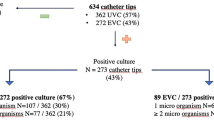Abstract
OBJECTIVE: Extremely low birth weight (ELBW) infants often acquire catheter-related infections (CRIs) when a percutaneously inserted central catheter (PICC) is used for parenteral nutrition or drug administration. Our objective was to compare the incidence of CRIs after we established a “PICC Maintenance Team” for the proactive management — compared to expectant management — of these lines.
STUDY DESIGN: We did a prospective collection and analysis of catheter-related sepsis data over a 15-month period from February 1, 1998 through May 1, 1999. Eligible patients included all neonates weighing <1000 g at birth.
RESULTS: There was a significantly decreased incidence of CRIs, to a rate of 7.1%, or 5.1/1000 catheter days (p<0.05).
CONCLUSION: “Proactive” management of PICC, significantly reduced the incidence of CRIs. The reduction in infection rate is estimated to save 180 hospitalized patient days/100 very low birth weight neonates, with a concomitant savings in morbidity and medical expense.
This is a preview of subscription content, access via your institution
Access options
Subscribe to this journal
Receive 12 print issues and online access
$259.00 per year
only $21.58 per issue
Buy this article
- Purchase on Springer Link
- Instant access to full article PDF
Prices may be subject to local taxes which are calculated during checkout
Similar content being viewed by others
References
Shaw JL . Parenteral nutrition in the management of sick low birthweight infants Pediatr Clin North Am 1973 20: 333–58
Riordan TP . Placement of central venous lines in the premature infant JPEN 1979 3: 381–2
Sasidharan P, Billman D, Heimler R, Nelin L . Cardiac arrest in an extremely low birthweight infant: complication of percutaneous central venous catheterization in a neonate J Perinatol 1996 15: 386–8
Keeney S, Richardson CJ . Extravascular extravasation of fluid as a complication of central venous lines in the neonate J Perinatol 1995 15: 284–8
Watkin SL, Stephenson TJ . Embolization of a percutaneous central venous catheter Clin Pediatr 1994 33: 26–127
Beattie PG, Kuschel CA, Harding JE . Pericardial effusion complicating a percutaneous central venous line in a neonate Acta Paediatr Sin 1993 82: 105–7
Wirrell EC, Pelausa EO, Allen AC, Stinson DA, Hanna BD . Massive pericardial effusion as a cause for sudden deterioration in a very low birthweight infant Am J Perinatol 1993 19: 419–23
Mupanemunda RH, Mackanjee HR . A life-threatening complication of percutaneous central venous catheters in neonates AJDC 1992 146: 1414–5
Seguin J . Right sided hydrothorax and central venous catheters in extremely low birth weight infants Am J Perinatol 1992 9: 154–8
Subhani MT, LaGamma EF . Percutaneous central venous catheter related infections correlate with the degree of immaturity rather than operator defined risk factors Pediatr Res 1998 47: 313A
Spafford PS, Sinkin RA, Cox C, Reubens L, Powell KR . Prevention of central venous catheter-related coagulase negative Staphylococcus sepsis in neonates J Pediatr 1994 125: 260–3
Mahieu LM, De Muynck AO, Leven MM, De Dooy JJ, Goossens HJ, Van Reempts PJ . Risk factors for central vascular catheter-associated bloodstream infections among patients in a neonatal intensive care unit J Hosp Infect 2001 48: 108–16
Leick-Rude MK . Use of percutaneous Silastic intravascular catheters in high risk neonates Neonat Network 1990 9: 17–25
Craft A, Finer N . Nosocomial coagulase negative staphylococcal (CoNS) catheter-related sepsis in preterm infants: definition, diagnosis, prophylaxis, and prevention J Perinatol 2001 21: 186–92
Salzman MB, Isenberg HD, Shapiro JF, Lipsitz PJ, Rubin LG . A prospective study of the catheter hub as the portal of entry for microorganisms causing catheter-related sepsis in neonates J Infect Dis 1993 167: 487–90
Salzman MB, Rubin LG . Intravenous catheter-related infections Adv Pediatr Infect Dis 1995 10: 337–68
Chathas MK, Paton J, Fisher D . Percutaneous central venous catheterization: three years' experience in a neonatal intensive care unit AJDC 1990 144: 1246–50
Goutail-Flaud M, Sfez M, Berg A, et al . Central venous catheter related complications in newborns and infants: a 587 case survey J Pediatr Surg 1991 26: 645–50
Stoll BJ, Gordon T, Krones SB et al. Early-onset sepsis in VLBW neonates: a report from the NICHD national research network J Pediatr 1996 129: 72–80
Singhal KK, LaGamma EF . Management of 168 neonates weighing more than 2000 g receiving intrapartum chemoprophylaxis for chorioamnionitis Arch Pediatr Adolesc Med 1996 150: 158–63
Leipala JA, Petaja J, Fellman V . Perforation complications of percutaneous central venous catheters in very low birthweight infants J Paediatr Child Health 2001 37: 168–71
Nadroo AM, Lin J, Green RS, Magid MS, Holzman IR . Death as a complication of peripherally inserted central catheters in neonates J Pediatr 2001 138: 599–601
Author information
Authors and Affiliations
Additional information
Presented, in part, at the Pediatric Academic Societies' Meeting, San Francisco, CA, May 1999.
Rights and permissions
About this article
Cite this article
Golombek, S., Rohan, A., Parvez, B. et al. “Proactive” Management of Percutaneously Inserted Central Catheters Results in Decreased Incidence of Infection in the ELBW Population. J Perinatol 22, 209–213 (2002). https://doi.org/10.1038/sj.jp.7210660
Published:
Issue Date:
DOI: https://doi.org/10.1038/sj.jp.7210660
This article is cited by
-
Prävention von Gefäßkatheter-assoziierten Infektionen bei Früh- und Neugeborenen
Bundesgesundheitsblatt - Gesundheitsforschung - Gesundheitsschutz (2018)
-
Letter regarding ‘Utilizing a line maintenance team to reduce central-line-associated bloodstream infections in a neonatal intensive care unit’
Journal of Perinatology (2013)
-
Reply: Utilizing a line maintenance team to reduce central-line-associated bloodstream infections in a neonatal intensive care unit
Journal of Perinatology (2013)
-
Reducing Central Line Infections in Pediatric and Neonatal Patients
Current Infectious Disease Reports (2013)
-
Randomized trial of percutaneous central venous lines versus peripheral intravenous lines
Journal of Perinatology (2007)



